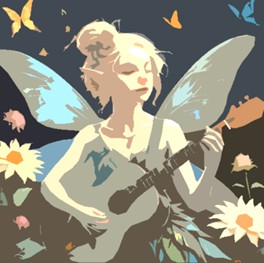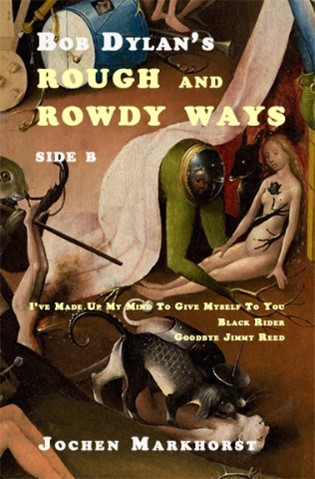by Jochen Markhorst
XXII From the chord fairy
 “Quite advanced playing, which requires precision and dexterity — not for the faint of heart!” says Eyolf Østrem on his acclaimed website Dylanchords – The Complete Chords and Lyrics of Bob Dylan (dylanchords.com). He is referring to the guitar part for “My Own Version Of You” by Blake Mills, the prodigy whose contributions have left such an unobtrusive but indispensable mark on Rough And Rowdy Ways. Contributions that we can attribute to Mills himself. In interviews, Blake confirms what we already know from dozens of other testimonials: “You don’t sit around with Bob and he explains the song to you – either you get it right away or you don’t,” he reveals in Uncut, June 2021. And three months earlier, in the Belgian magazine Knack (9 March 2021), he was equally unequivocal:
“Quite advanced playing, which requires precision and dexterity — not for the faint of heart!” says Eyolf Østrem on his acclaimed website Dylanchords – The Complete Chords and Lyrics of Bob Dylan (dylanchords.com). He is referring to the guitar part for “My Own Version Of You” by Blake Mills, the prodigy whose contributions have left such an unobtrusive but indispensable mark on Rough And Rowdy Ways. Contributions that we can attribute to Mills himself. In interviews, Blake confirms what we already know from dozens of other testimonials: “You don’t sit around with Bob and he explains the song to you – either you get it right away or you don’t,” he reveals in Uncut, June 2021. And three months earlier, in the Belgian magazine Knack (9 March 2021), he was equally unequivocal:
“The most important thing is that you put yourself at the service of the song, the story or the mood. But of course you can also follow your instincts. Dylan doesn’t tell you exactly what to play. He does expect you to play what needs to be played. That may seem the same, but it’s a world of difference.”
Even more illuminating are the seven short films Blake Mills posted on his Instagram account in June 2020, shortly after the release of Rough And Rowdy Ways. Short videos, no longer than a minute (except for “Black Rider”, which lasts 1’35”), visually unspectacular, but breathtaking in content: in each video, he demonstrates his contributions to seven songs from Rough And Rowdy Ways on his guitar (“I Contain Multitudes”, “False Prophet”, “Mother Of Muses”, “My Own Version Of You”, “Crossing The Rubicon”, “Black Rider” and “I’ve Made Up My Mind To Give Myself To You”).
The ingenuity of Multitudes, the accents with the slide on Prophet, the part for I’ve Made Up My Mind that almost all reviewers thought was played on a marimba (or steel drums, or a xylophone), but now turns out to be a guitar after all; Blake’s old Telecaster, a muting thumb on the bass strings and lightning-fast triplets with the fingers of his right hand on the lower strings… and that atmospheric, goosebump-inducing part on “My Own Version of You”. We hear what Blake’s “instinct” told him, what he thought needed to be played, what Dylan’s song expected of him: that descending bass line as if he hears Cole Porter’s “Night And Day” in it and the jazzy Duke Ellington-esque embellishments whose “dexterity” and “precision” Eyolf Østrem so admires. Chords and accents that you wouldn’t immediately associate with Dylan, by the way. One of the followers writes under the Blake Mills video: “I was wondering where Dylan got those chords from.” To which Mills replies: “From the chord fairy.” Chords that Eyolf manages to decipher, thanks in part to the video:
Am /g /g♭ /f All through the summers, into January Am /g /g♭ /f I've been visiting morgues and monasteries Dm7 F/c G7/b Bb7 Looking for the necessary body parts Am /a♭ /g /g♭ Limbs and livers and brains and hearts F7 I'll bring someone to life, is what I wanna do Am I'm gonna create my own version of you
… all in all, it is quite clear why Dylan is so fond of Mills, who incidentally, is practically Dylan’s neighbour kid in Malibu.
That descending bass line helps Tony Attwood crack the most idiosyncratic aspect of the musical backdrop to “My Own Version Of You”: the missing beat. Attwood, the musicologist who, in his series “No Nobel Prize For Music” and elsewhere, often delights us with surprising discoveries in Dylan’s music, especially in the area of peculiar time signatures and unobtrusive, “hidden” beats, missing bars or extra half bars – such as the half bar of two beats at the end of each line of “Not Dark Yet”. Here in “My Own Version Of You”, Tony points to an almost subliminal peculiarity that has escaped every analyst:
There is the basic 123 123 123 going on from the start. And on each 1 of the 123 the descending bass runs, so we get:
Bass A 1 = 1 2 3 All through the
Bass G 2 = 1 2 3 summers into
Bass G♭ 3 = 1 2 3 January
Bass F 4 = 1 2 3 I’ve been….
I think if I were writing out the music I might call that 12/8 and it takes us through the sections of the triple time ( 1 2 3 – 1 2 3). You can hear the bass line going through four beats. But …. at the end of each verse after “my own version of you” Bob cuts a beat – so instead of getting a perfect 12 beats we only get three of those 1 2 3 lines. not four.
If you can hear that solid beat at the start of each 3 beats you hear:
1 create my
2 own
3 version of
1 you (2 3 4)
So instead of a group of four sets of three for a perfect 12/8 time signature, we get a bar of 9/8 for “Create my own version of”, as the word “you” takes us back to the 12/8 bars signified by the four notes of the descending bass.
Because the music sounds fairly spooky, we don’t particularly hear the missing beat – but perhaps subconsciously we feel something is missing, and it is associated with the word “you” which again makes the whole thing feel a bit strange. And this must be deliberate by Bob because this is a very spooky song.
Here’s another way of looking at and hearing it by focusing on the first of each group of three beats. 1 represents the solid beat – the first of the three:
1 2 3 4 1 2 3 4
All through the summers into January I’ve been
1 1 1 1
visiting morgues and monasteries
1 1 1 1
Looking for the necessary body parts
1 1 1 1
Limbs and livers and brains and hearts
1 1 1 1
I’ll bring someone to life is what I wanna do
1 1 1 1
I wanna create my own version of
1 1 1
You
1 2 3 4
I would certainly write this in 12/8 time with that final line with the missing beat as 9/8. It is so cleverly done that we don’t hear it as something wrong, but rather as an emphasis on the “You” – the feeling that we must continue on.
The first two verses are five lines of the straight 12/8 with then the missing beat line, but then Bob changes the number of lines.
Then in the penultimate verse we are following a route that is similar to the opening verse. That makes us think we are at the end. Except that we still get that enormous final verse. This is like the first verse and with that variation in the final line – it is straight 12/8 and we have the change to 9/8 for the last line, “Do it with laughter and do it with….” are on just beats (i.e. 3 strong beats) with “tears” clearly the first of another group of three. We are back to the start.
Of course many people don’t take in the subtle changes that Bob brings in and takes out, but it means that the song does catch us out over and over again
Do it with laughter and do it with
tears
… and that tells us perhaps subconsciously (for non-musicians ) that we are at the end.
Blake Mills’ instinct is not only inspired by the chord fairy, but also by Chronos the Timekeeper.
———————–
Jochen is a regular reviewer of Dylan’s work on Untold. His books, in English, Dutch and German, are available via Amazon both in paperback and on Kindle: 
- Blood on the Tracks: Dylan’s Masterpiece in Blue
- Blonde On Blonde: Bob Dylan’s mercurial masterpiece
- Where Are You Tonight? Bob Dylan’s hushed-up classic from 1978
- Desolation Row: Bob Dylan’s poetic letter from 1965
- Basement Tapes: Bob Dylan’s Summer of 1967
- Mississippi: Bob Dylan’s midlife masterpiece
- Bob Dylan’s Greatest Hits
- John Wesley Harding: Bob Dylan meets Kafka in Nashville
- Tombstone Blues b/w Jet Pilot: Dylan’s lookin’ for the fuse
- Street-Legal: Bob Dylan’s unpolished gem from 1978
- Bringing It All Back Home: Bob Dylan’s 2nd Big Bang
- Time Out Of Mind: The Rising of an Old Master
- Crossing The Rubicon: Dylan’s latter-day classic
- Nashville Skyline: Bob Dylan’s other type of music
- Nick Drake’s River Man: A very British Masterpiece
- I Contain Multitudes: Bob Dylan’s Account of the Long Strange Trip
- Bob Dylan’s Rough And Rowdy Ways – Side B
- Bob Dylan’s High Water (for Charley Patton)
- Bob Dylan’s 1971
- Like A Rolling Stone b/w Gates Of Eden: Bob Dylan kicks open the door
